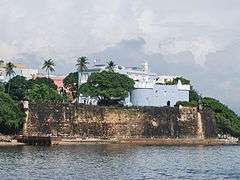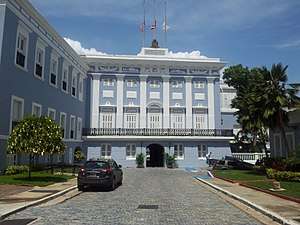La Fortaleza
La Fortaleza (The Fortress) is the official residence of the Governor of Puerto Rico. It was built between 1533 and 1540 to defend the harbor of San Juan. The structure is also known as Palacio de Santa Catalina[3] translative (Santa Catalina's Palace) on in continuous use in the New World. It was listed by UNESCO in 1983 as part of the World Heritage Site "La Fortaleza and San Juan National Historic Site".
| La Fortaleza | |
|---|---|
 La Fortaleza from San Juan Harbor | |

| |
| Alternative names | Palacio de Santa Catalina |
| General information | |
| Architectural style | Classical Revival, Other |
| Location | San Juan, Puerto Rico |
| Address | 63 Calle Fortaleza, San Juan, Puerto Rico 00901 |
| Country | Puerto Rico |
| Coordinates | 18°27′50″N 66°7′9″W |
| Completed | 1540 |
| Website | |
| Official Govt. of Puerto Rico Site (in Spanish) | |
| Type | Cultural |
| Criteria | vi |
| Designated | 1983 (7th session) |
| Part of | La Fortaleza and San Juan National Historic Site in Puerto Rico |
| Reference no. | 266 |
| State Party | United States |
| Region | The Americas |
| Official name | La Fortaleza |
| Designated | October 9, 1960[1] |
| Reference no. | 66000951 |
| Official name | La Fortaleza |
| Designated | October 15, 1966[2] |
During the 1640 reconstruction, the chapel of Santa Catalina, which originally existed outside the walls, was demolished and was integrated to the walls of the structure, resulting in the alternate name Santa Catalina's Castle.
The structure

La Fortaleza was the first defensive fortification built for the city of San Juan, and the first of a series of military structures built to protect the city which included the Fort San Felipe del Morro and the Fort San Cristóbal. The construction was authorized by Charles V, Holy Roman Emperor as a defense against attacks from Island Caribs and the European powers of the time.
Initially, the structure consisted of four walls enclosing an interior patio with a circular tower known as the Homage Tower. From the top of the tower, the governor, following military tradition, would take oaths of fidelity at critical moments to the King and Queen of Spain. Later, a second tower named the Austral Tower was constructed.
At present, the complex consists of a few attached buildings with formal living quarters in the second floor, and private quarters in the third. It overlooks the high city walls that front the bay, and within the north perimeter of the house are sheltered gardens and a swimming pool.
History
Starting in 1529, Governor La Gama petitioned the emperor on the need to build defensive fortifications, "because the island's defenseless condition caused the people to emigrate." Construction started in 1533, with the use of stone, and concluded by 1540. Yet the fort had no guns, and Gonzalo Fernández de Oviedo y Valdés commented "if it had been constructed by blind men could not have been located in a worse location." Yet the structure has served as the governor's residence since 1544.[4][5]
Since the 16th century, La Fortaleza has acted as the residence of the Governor of Puerto Rico, making it the oldest executive mansion in continuous use in the Americas.[6] On November 27, 1822, its traditional status as the executive mansion was made official. The fortress underwent a massive reconstruction in 1846 to change its military appearance into a palatial facade. La Fortaleza has been the residence of more than 170 governors of Puerto Rico and has hosted various dignitaries, including President John F. Kennedy and his wife Jacqueline Kennedy who stayed in La Fortaleza in 1961. King Juan Carlos of Spain and Queen Juliana of the Netherlands are among several heads of state who have stayed in La Fortaleza. In June 2011, U.S. President Barack Obama visited the mansion during a brief trip to the island marking the first visit of an in-office US President to the Fortaleza as well as the Island on official business since Kennedy, 50 years previously to that date. King Felipe VI and Queen Letizia of Spain also visited La Fortaleza in 2016.

La Fortaleza has been captured twice by invaders:
- 1598, George Clifford, Earl of Cumberland, attacked San Juan.
- 1625, General Boudewijn Hendrick (Balduino Enrico) of the Netherlands invaded the city and established himself at La Fortaleza. During the Dutch retreat, the fortress and the city were set ablaze.
In 1834, Colonel George Dawson Flinter described the fortress of Santa Catalina as having a chapel, stables and a cistern as well as an east wing with spacious apartments.[7]
According to tradition, in 1898, just before the United States invaded Puerto Rico during the Spanish–American War, the last Spanish governor of the island, Ricardo De Ortega, struck a longcase clock in La Fortaleza with his sword, stopping the clock and marking the time at which Spain lost control over Puerto Rico.
On October 30, 1950, there was an attempt by a few nationalists to enter La Fortaleza in what is known as the San Juan Nationalist revolt, intending to attack then-governor Luis Muñoz Marín. The 5-minute shootout resulted in four Nationalists dead: Domingo Hiraldo Resto, Carlos Hiraldo Resto, Manuel Torres Medina and Raímundo Díaz Pacheco. Three of the guards of the building, among them Lorenzo Ramos, were seriously injured.
On October 9, 1960, La Fortaleza was designated a United States National Historic Landmark.[1][8]
In 1983, La Fortaleza, along with the San Juan National Historic Site, was declared a World Heritage Site by UNESCO.[9]
On May 26, 2004, a man armed with a knife entered the mansion's mailroom located just outside the palace gates and took a receptionist hostage. The 2½ hour stand-off ended after Governor Sila María Calderón entered the building and listened as the hostage-taker read a letter.
From July 13 to July 24, 2019, the surrounding streets around La Fortaleza were the scene of various protests as part of Telegramgate as a result of leaked messages involving Governor Ricardo Rosselló. As protesters continued to demand the governor to step down on July 24, 2019, Rosselló announced his resignation from office, effective August 2, 2019.
In literature
In 2011, Puerto Rican author Giannina Braschi wrote the dramatic novel United States of Banana, featuring climactic scenes of revolution at La Fortaleza.
See also
- List of United States National Historic Landmarks in United States commonwealths and territories, associated states, and foreign states
- National Register of Historic Places listings in metropolitan San Juan, Puerto Rico
References
- Government of Puerto Rico. Executive Mansion: Santa Catalina's Palace. San Juan, Puerto Rico. (in Spanish)
- World Heritage Committee. Report of 7th Session, Florence 1983. Paris: UNESCO's Convention Concerning the Protection of the World Cultural and Natural Heritage. January 1984.
- "La Fortaleza". National Historic Landmark summary listing. National Park Service. Archived from the original on 2007-08-09. Retrieved 2007-06-28.
- "National Register Information System". National Register of Historic Places. National Park Service. April 15, 2008.
- Rivero Méndez, Ángel (2 September 2019). "Crónica de la guerra hispano-americana en Puerto Rico". Wikisource (in Spanish). p. 23. Retrieved 2 September 2019.
- Van Middeldyk, R.A. (1903). Brumbaugh, Martin (ed.). The History of Puerto Rico: From the Spanish Discovery to the American Occupation. D. Appleton and Company. pp. 109-110. Retrieved 6 March 2019.
- The Forts of Old San Juan. Washington, D.C.: Division of Publications, National Park Service, U.S. Dept. of the Interior. 2018. pp. 24–27. ISBN 9780912627625.
- "Collections". National Museum of American History. Retrieved 13 April 2018.
- Flinter, George Dawson (23 October 2016). "An Account of the Present State of the Island of Puerto Rico". Internet Archive. Retrieved 5 May 2020.
- McKithan, Cecil N. (August 1981). "National Register of Historic Places Inventory-Nomination: La Fortaleza". National Park Service. and Accompanying photos and diagrams, undated
- "WH Committee: Report of 7th Session, Florence 1983". whc.unesco.org. Retrieved 13 April 2018.
External links
| Wikimedia Commons has media related to La Fortaleza. |